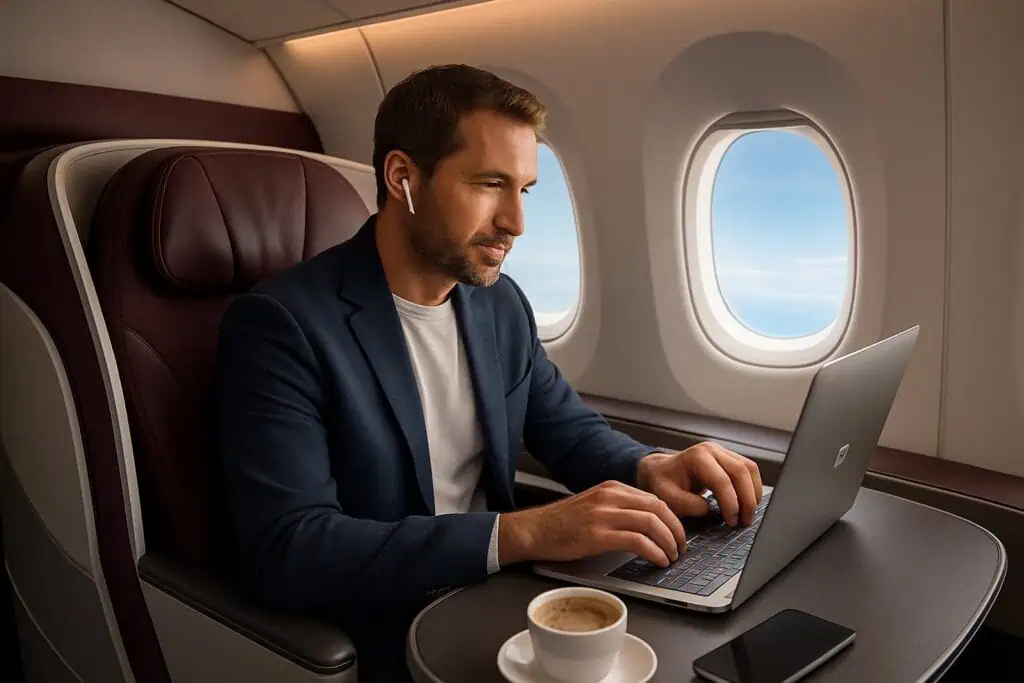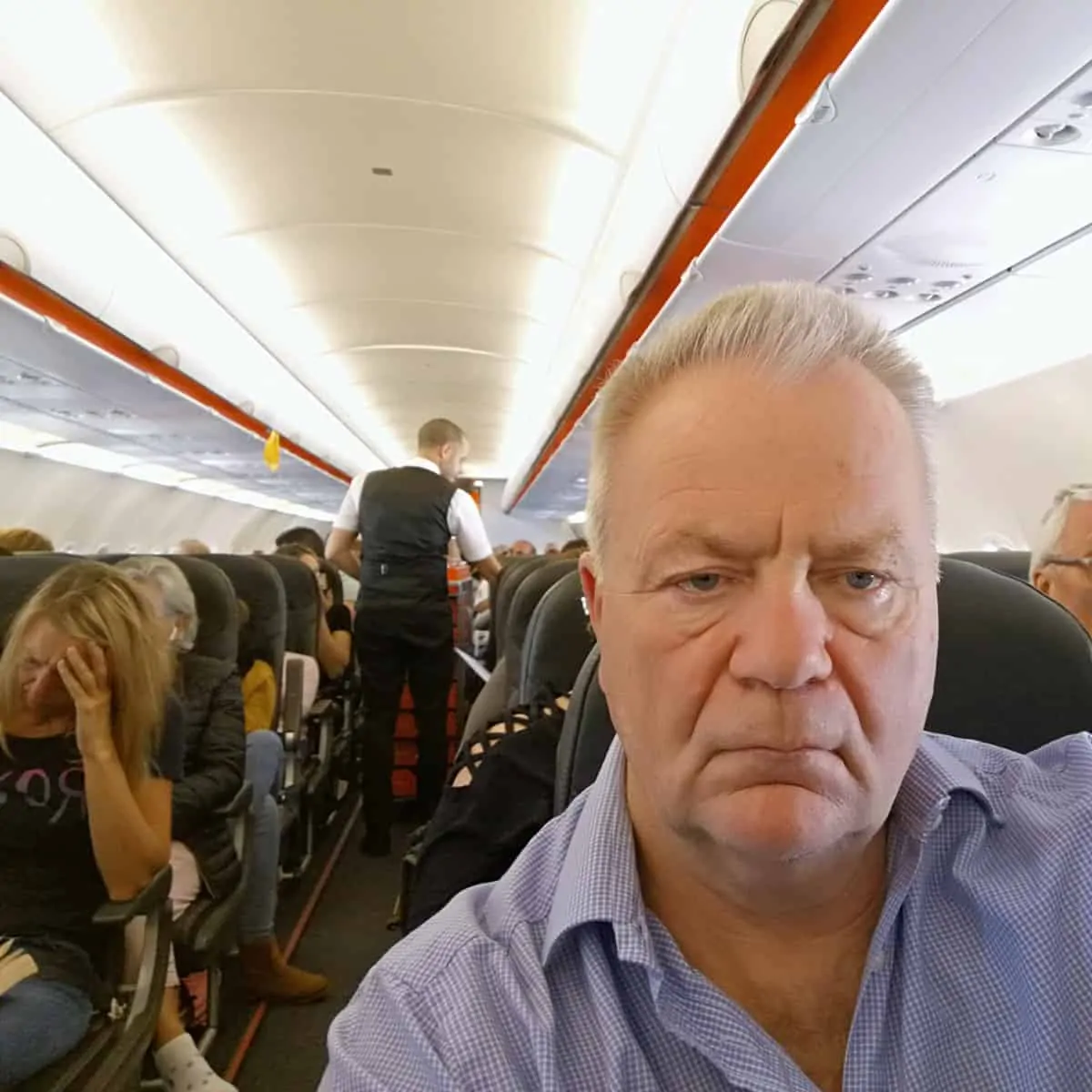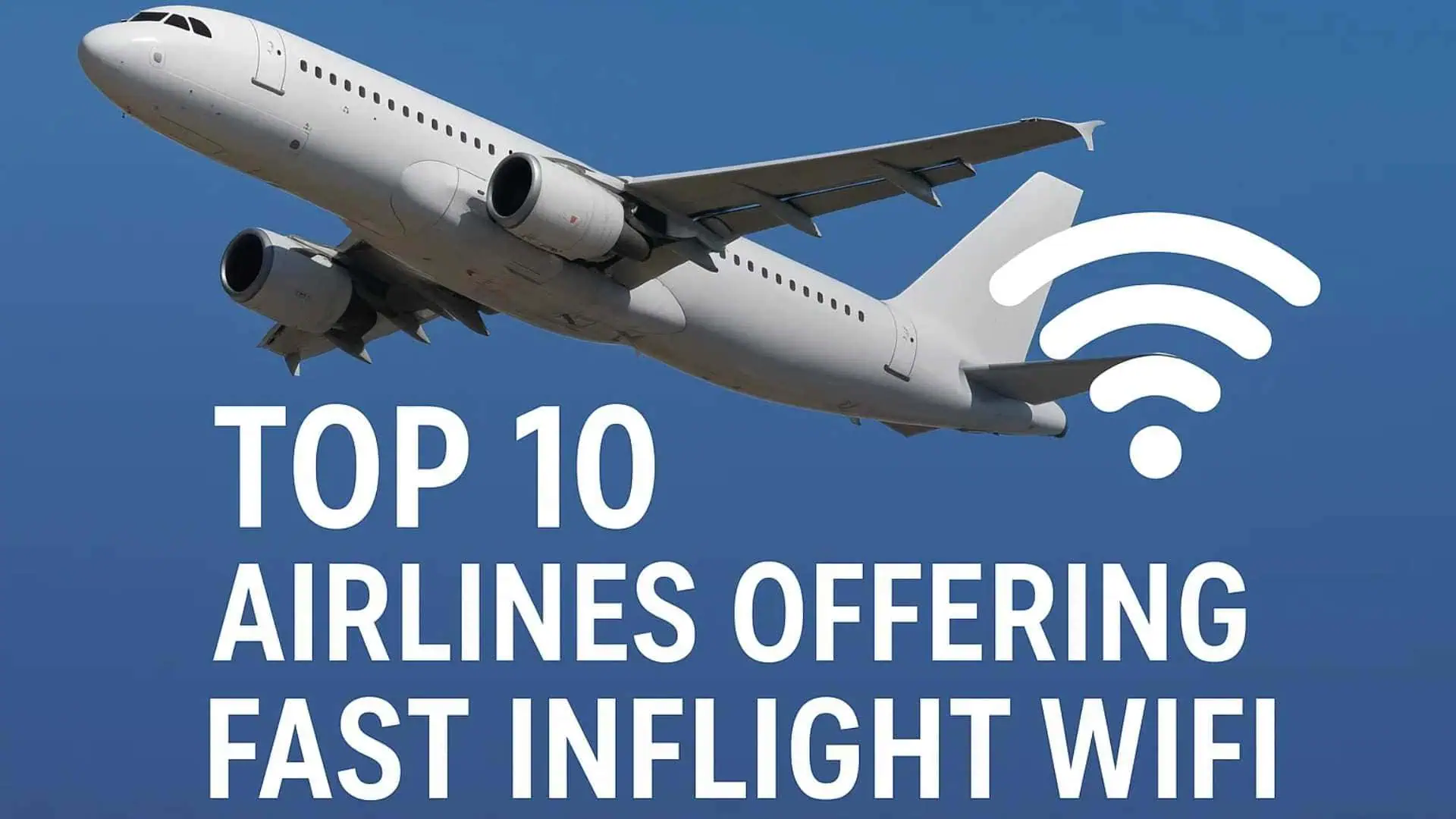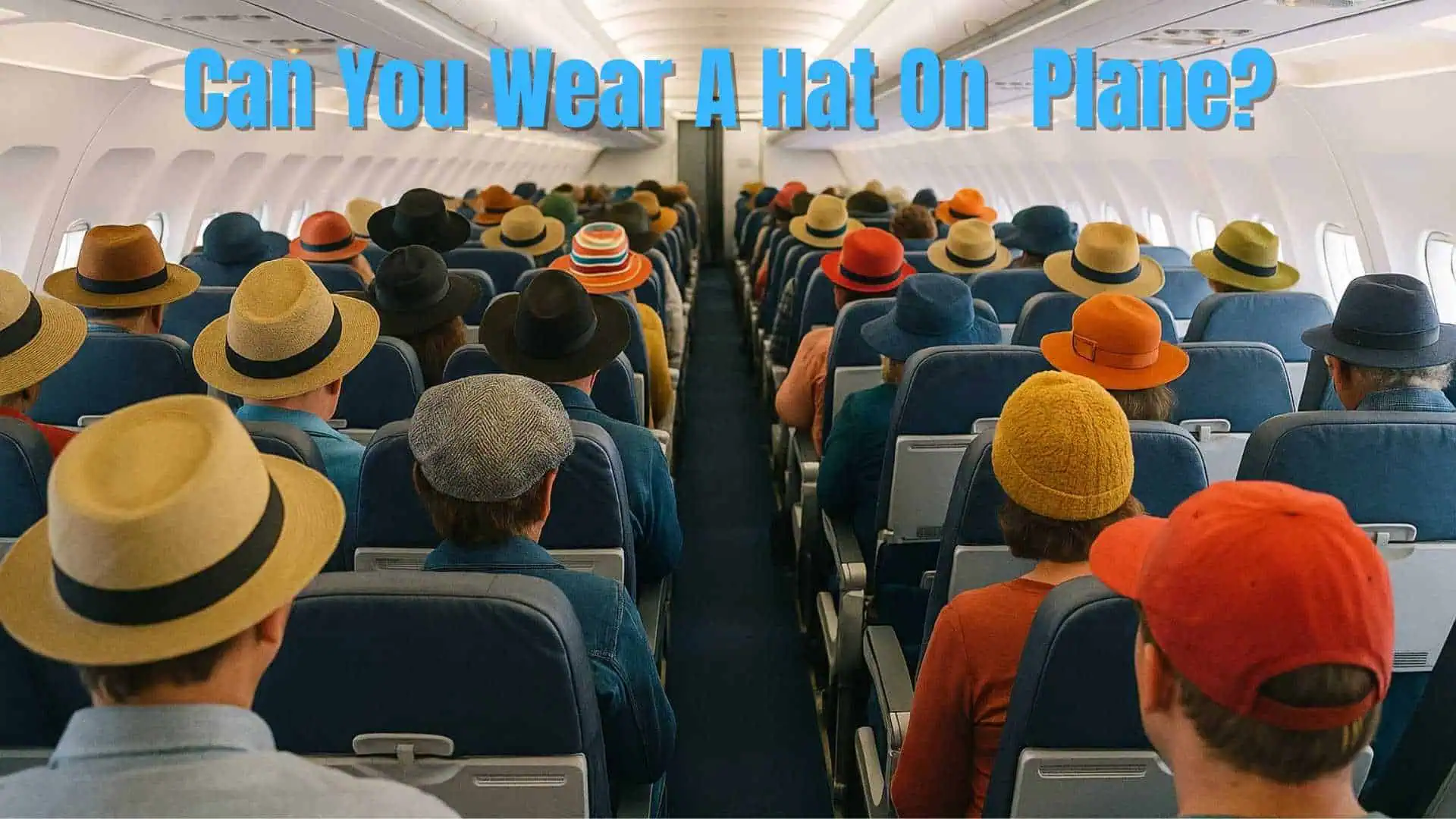Flying used to mean being cut off from the internet (and the world) for hours at a time. Now, most airlines have wifi so you can keep up with work, chat, or binge-watch something at 30,000 feet. But let’s be honest, wifi quality still swings wildly depending on who you’re flying with.
Some airlines now provide wifi speeds that rival what you get at home, while others still offer slower connections that work for basic browsing and messaging.
Whether you need to work during your flight, stay in touch with family, or just want to stream movies, choosing the right airline can make a big difference in your travel experience.

Understanding which carriers offer the fastest and most reliable wifi will help you pick the best option for your next trip.
Contents
1. Hawaiian Airlines
Hawaiian Airlines takes the top spot for fastest in-flight Wi-Fi based on recent speed tests. If you want the best inflight internet out there, this is probably it.
They use Starlink’s satellite network to power their wifi. That means you’ll get faster speeds and a more stable connection than you’d find on most other airlines.
You can connect to Wi-Fi as soon as you board, skipping those annoying registration pages and payment screens. It’s totally free on every flight.
The fast speeds let you stream videos, play online games, and video chat with people on the ground. You can also check emails and share photos on social media without frustrating delays.
Hawaiian Airlines partnered with Elon Musk’s Starlink to offer this premium internet service. The low Earth orbit satellites provide much better performance than older satellite systems.
2. Qatar Airways
Qatar Airways stands out as one of the best performing airlines using in-flight Wi-Fi connectivity. You’ll get complimentary Starlink Wi-Fi from gate to gate—no fees, no catch.
They rely on Starlink’s low-Earth orbit satellites, which deliver much faster speeds than the old-school airplane internet. You might even see download speeds of up to 500 megabits per second.
Qatar Airways offers this ultra-fast internet service for free. Streaming, VPNs, online gaming—it all works, and honestly, it feels a lot like your home connection (which is wild for a plane).
The airline has been rolling out Starlink across its fleet quickly. Hawaiian Airlines and Qatar Airways took top honors for the best download and upload speeds among 30 airlines tested.
You’ll find Qatar Airways among the airlines fully upgraded to Starlink. This puts them ahead of many other major carriers still using slower internet systems.
3. Delta Air Lines
Delta’s been shaking things up with their wifi lately. Now, SkyMiles Members get free Wi-Fi on most domestic flights, and they’re working on rolling this out internationally too.
They’ve switched to Viasat Ka-Band internet, which is way faster than what they had before. You’ll notice the difference if you’ve flown Delta a lot.
Delta plans to install this upgraded wifi on over 500 planes. If you’re flying on a plane without the free service, you can still get high-speed internet for just $5.00 per flight.
The Delta Wi-Fi service works with smartphones, tablets, and laptops. You can work, stream videos, or stay connected during your flight.
Delta joined JetBlue as one of the few major US airlines to offer free inflight wifi. This makes them a good choice if you need reliable internet while flying.
4. JetBlue Airways
JetBlue’s got bragging rights as the first and only major U.S. airline to offer free Wi-Fi on all flights. No sneaky fees—Fly-Fi is included.
They went with Viasat Ka technology for their entire fleet, so you’ll get fast, stable internet no matter where you sit.
You can connect unlimited devices to JetBlue’s Wi-Fi network. This means your phone, tablet, and laptop can all stay connected at the same time.
JetBlue waited longer than other major airlines to offer in-flight Wi-Fi. But this delay let them install better technology from the start.
They’ve been running Fly-Fi for a decade now, and it’s basically unlimited broadband satellite internet—feels almost like what you get at home.
JetBlue ranks among the top airlines for Wi-Fi quality. You can stream, work, or just scroll endlessly without much hassle.
The free Wi-Fi works on both domestic and international flights. You don’t need to worry about extra charges or time limits.
5. American Airlines
American Airlines gives you upgraded, high-speed Wi-Fi on select domestic flights. You can browse, check emails, and even stream Netflix or Hulu if you want.
They switched from slow, ground-based internet to fast satellite-based service on over 900 planes. The difference is pretty noticeable if you’ve dealt with the old system.
You can buy Wi-Fi packages right from the American Airlines app or through the in-flight entertainment screen. Prices depend on your flight and what package you pick.
To connect, just look for the American Airlines network in your device’s Wi-Fi settings. Once you select it, a browser should pop up so you can buy access.
American Airlines does offer free Wi-Fi, but there’s a catch. You’ll need to meet certain requirements to get it without paying.
You can check if your specific flight has Wi-Fi by looking at your boarding pass or checking online before you travel.
6. United Airlines
United Airlines provides inflight Wi-Fi on almost all flights. You can stay connected whether you’re flying domestic or international routes.
They’ve teamed up with top providers, so you’ll usually have reliable wifi on United flights. That’s honestly more than you can say for some airlines.
Access costs $8 per flight for Mileage Plus members and $10 for non-members. United also offers subscription options if you fly frequently.
If you’re a T-Mobile customer, you’re in luck. United partners with T-Mobile and offers free internet access to T-Mobile users. This depends on your plan eligibility.
The best news is just starting to happen. Starting in May 2025, the first United flights will go live with free high-speed Wi-Fi powered by Starlink. This means faster and more reliable internet from gate to gate.
You can also enjoy free messaging through internet-based platforms. This makes staying in touch with family and friends easier during your flight.
7. Alaska Airlines
Alaska Airlines offers inflight Wi-Fi on most of its aircraft to keep you connected during your flight. The airline is upgrading its fleet to satellite-based internet service for better speeds.
You’ll find two types of Wi-Fi depending on your aircraft. The Boeing 737 planes use Gogo 2Ku service for faster speeds. Regional jets use Gogo’s ATG4 service with free chat features.
Alaska Airlines charges $8 per flight for Wi-Fi access. This flat rate applies to all flight lengths, making it a good deal for longer trips.
If you have certain T-Mobile plans, you can get free inflight Wi-Fi on Alaska Airlines flights. Check with T-Mobile to see if your plan includes this benefit.
The airline has equipped 80% of its fleet with Wi-Fi service. You can use it for email, social media, and browsing the web during your flight.
Alaska Airlines doesn’t offer free Wi-Fi to all passengers. You’ll need to pay the $8 fee or use a qualifying T-Mobile plan to get online.
8. Southwest Airlines
Southwest Airlines gives you Wi-Fi on most flights for a flat $8 per device. Knowing the price upfront makes it a lot easier to budget for your internet needs in the air.
They run a satellite-connected internet system across their fleet, so you can browse, check your email, and stay in touch while flying.
Southwest’s inflight entertainment portal lets you watch movies, live TV, and listen to music for free on your own device. Messaging apps like iMessage and WhatsApp work at no charge, which is a nice touch.
If you’re an A-List Preferred member or hold a Southwest credit card, you get Wi-Fi for free—a good perk if you fly with them often.
Southwest’s Wi-Fi only works during the domestic parts of international flights, so keep that in mind if you’re leaving the country.
Their no-frills style extends to Wi-Fi too. Speeds aren’t the fastest out there, but the $8 flat rate keeps it pretty accessible for most folks.
Just buy Wi-Fi access once you’re on the plane and connected to their network.
9. Lufthansa
Lufthansa’s FlyNet service gives you solid internet access while you’re in the air. The German airline offers both time-based and data-based plans, so you can pick what works for you.
You get several pricing options depending on how you plan to use the internet. Messaging, browsing, email, even some video streaming—it all works pretty smoothly.
Lufthansa’s FlyNet stands out for its mix of affordability, speed, and how easy it is to use. Honestly, it’s one of the more advanced in-flight Wi-Fi setups out there right now.
The airline sells Wi-Fi passes that usually cost between $5 an hour and $30 for a whole flight. Sometimes you can even buy access before you board, which is handy.
Lufthansa’s system keeps you connected throughout your journey. The FlyNet service handles most online needs, so you can work or chat with family and friends while flying.
10. Emirates
Emirates puts WiFi on just about every flight they run, so you can stay connected whether it’s a short hop or a long haul.
The airline has both free and paid WiFi. Emirates now gives basic complimentary inflight WiFi to all passengers, no matter your cabin or destination.
If you want faster speeds, you can upgrade to a paid plan. Unlimited WiFi usually runs $10-20 depending on the flight, which is pretty much in line with what other major airlines charge.
To log in, you’ll need your Emirates Skywards membership number. Just use your birth date from your Skywards profile and your seat number from the boarding pass to get started.
Don’t forget to add your membership number to the booking before you fly. You can do this in the Emirates app or by managing your booking online.
Emirates focuses on solid connectivity across their network. The WiFi is good for basic browsing, messaging, and some light streaming—not really for heavy downloads, but it gets the job done.
Understanding Inflight Wifi Technology

Most airlines use one of two main internet systems to keep you online at 35,000 feet. The speed and quality you get depends on the tech your airline uses and a handful of factors that can mess with the signal during your flight.
Satellite vs. Ground-Based Systems
Airlines connect you online in two ways. Ground-based systems rely on cell towers down below to send signals up to the plane.
These work fine over land but hit a wall over oceans or remote places where there just aren’t any towers.
Satellite systems beam internet straight from space to your aircraft. They work anywhere, whether you’re over water or mountains.
Most airlines lean toward satellite internet these days because it covers more ground (well, sky). Airlines keep trying to boost WiFi speed and reliability by rolling out newer satellite tech.
Starlink is a newer satellite system popping up on more airlines. It uses thousands of smaller satellites that orbit closer to Earth than the old-school ones.
With the satellites closer, you get faster speeds and less lag when you click or send a message.
How Airlines Ensure Fast Connectivity
Airlines team up with internet companies to deliver WiFi. The big names are Viasat and Gogo.
These partners install special equipment on planes—antennas on top, computers inside the cabin.
Airlines regularly test their wifi setups to make sure everything works, and they upgrade hardware when new tech comes out.
Bandwidth management lets airlines control internet speed. They limit each passenger’s data so everyone gets a fair shot at a decent connection.
Some airlines offer speed tiers. Pay more for faster internet, or stick with the basic plan for things like checking email.
They also put servers closer to busy flight paths, which cuts down on how far your data has to travel, making sites load a bit quicker.
Factors That Affect Wifi Speeds in the Air
Lots of things can slow down your connection mid-flight. Weather is a big one—heavy clouds, storms, rain, all of it can block satellite signals and make your connection crawl or drop entirely.
Where the plane is matters too. Flights over oceans usually get slower internet than those over land.
The number of people online at once affects speed for everyone. More users = slower WiFi, unfortunately.
Flight altitude can mess with signal strength as well. Planes at different heights might get better or worse connections.
Time of day plays a role. More people jump online during business hours, which can bog down the shared link.
And the type of device you’re using matters. Newer phones and laptops usually connect better than old ones.
Tips for Making the Most of Inflight Wifi
If you want the best WiFi experience in the air, a little planning goes a long way. The way you prep your devices and use your connection can really make or break your time online up there.
Use a VPN
The most important advice is to always use a VPN, not only when accessing inflight wifi, but at most other times too.
Using a reliable VPN on public Wi-Fi networks adds an extra layer of security, making any intercepted data unusable. It’s not just tech magic; it’s peace of mind, allowing you to sip that in-flight mojito without a worry in the cyberworld.
I have been using Surfshark for a number of years. I have always found it reliable and affordable, whereever I am in the world.
You can check Surfshark VPN out here and try it free at first to see if you like it – Surfshark VPN
Best Practices for Streaming and Browsing
Download what you can before takeoff. Netflix, Spotify, YouTube—they all let you save stuff offline, so you won’t eat up inflight data.
Shut down extra apps and tabs to keep your device running smooth. Extra stuff in the background can slow your connection and kill your battery faster than you’d expect.
Stick with lightweight sites when you’re browsing. Mobile versions usually load way faster than desktop ones on slow WiFi.
Skip video calls and big uploads during busy times. They use a ton of bandwidth and, honestly, they rarely work well on most airline networks.
Clear your browser cache before you connect. Old stored data sometimes gets in the way when you’re trying to load fresh pages.
Pick a lower streaming quality if you have to stream. 480p or lower uses less data and tends to buffer way less than HD.
Personal Device Preparation Before Your Flight
Update your apps and operating system while you’ve still got speedy wifi on the ground. You never know when a fresh update will squash a bug or stop an app from crashing mid-flight.
Charge your devices fully—you’ll burn through battery way faster when you’re using inflight wifi. Toss a portable charger in your bag too, just in case.
Download offline maps from Google Maps or Apple Maps for wherever you’re headed. It’s a lifesaver if you can’t get online and still need to find your hotel or a coffee shop.
Sync cloud storage before you leave so you can grab important files even if you lose internet. Google Drive, Dropbox, iCloud—they all let you keep docs local if you remember to set it up.
Set up mobile hotspot capabilities on your phone, just as a backup. Sometimes, your own cellular data beats the spotty connection on the plane (though, honestly, it’s a toss-up).
Clean up device storage for better performance. Delete old photos, random videos, and all those apps you downloaded once and never opened again.

I have been traveling around the world by air since the early 70s and living overseas too. I worked for British Airways for a number of years and I am also a private pilot. About Me


